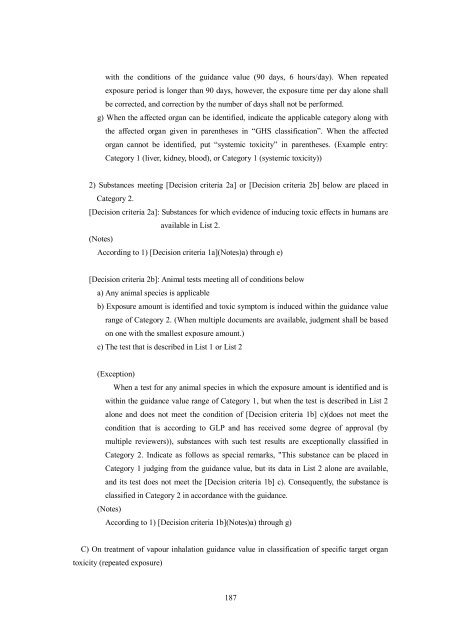GHS Classification Guidance for the Japanese Government
GHS Classification Guidance for the Japanese Government
GHS Classification Guidance for the Japanese Government
You also want an ePaper? Increase the reach of your titles
YUMPU automatically turns print PDFs into web optimized ePapers that Google loves.
with <strong>the</strong> conditions of <strong>the</strong> guidance value (90 days, 6 hours/day). When repeated<br />
exposure period is longer than 90 days, however, <strong>the</strong> exposure time per day alone shall<br />
be corrected, and correction by <strong>the</strong> number of days shall not be per<strong>for</strong>med.<br />
g) When <strong>the</strong> affected organ can be identified, indicate <strong>the</strong> applicable category along with<br />
<strong>the</strong> affected organ given in paren<strong>the</strong>ses in “<strong>GHS</strong> classification”. When <strong>the</strong> affected<br />
organ cannot be identified, put “systemic toxicity” in paren<strong>the</strong>ses. (Example entry:<br />
Category 1 (liver, kidney, blood), or Category 1 (systemic toxicity))<br />
2) Substances meeting [Decision criteria 2a] or [Decision criteria 2b] below are placed in<br />
Category 2.<br />
[Decision criteria 2a]: Substances <strong>for</strong> which evidence of inducing toxic effects in humans are<br />
(Notes)<br />
available in List 2.<br />
According to 1) [Decision criteria 1a](Notes)a) through e)<br />
[Decision criteria 2b]: Animal tests meeting all of conditions below<br />
a) Any animal species is applicable<br />
b) Exposure amount is identified and toxic symptom is induced within <strong>the</strong> guidance value<br />
range of Category 2. (When multiple documents are available, judgment shall be based<br />
on one with <strong>the</strong> smallest exposure amount.)<br />
c) The test that is described in List 1 or List 2<br />
(Exception)<br />
When a test <strong>for</strong> any animal species in which <strong>the</strong> exposure amount is identified and is<br />
within <strong>the</strong> guidance value range of Category 1, but when <strong>the</strong> test is described in List 2<br />
alone and does not meet <strong>the</strong> condition of [Decision criteria 1b] c)(does not meet <strong>the</strong><br />
condition that is according to GLP and has received some degree of approval (by<br />
multiple reviewers)), substances with such test results are exceptionally classified in<br />
Category 2. Indicate as follows as special remarks, "This substance can be placed in<br />
Category 1 judging from <strong>the</strong> guidance value, but its data in List 2 alone are available,<br />
and its test does not meet <strong>the</strong> [Decision criteria 1b] c). Consequently, <strong>the</strong> substance is<br />
classified in Category 2 in accordance with <strong>the</strong> guidance.<br />
(Notes)<br />
According to 1) [Decision criteria 1b](Notes)a) through g)<br />
C) On treatment of vapour inhalation guidance value in classification of specific target organ<br />
toxicity (repeated exposure)<br />
187
















